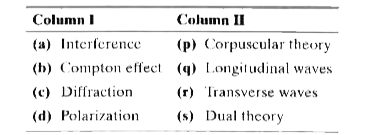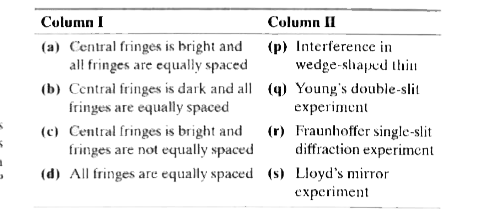When waves from two herent sources, having amplitudes a and b superimpose, the amplitude R of the resultant wave is given by R=√a2+b2+2abcosϕ where ϕ is the constant phase angle between the two waves. The resultant intensity I is directly proportional to the square of the amplitude of the resultant wave, i.e., I∝R2,
i.e., I∝(a2+b2+2abcosϕ)
For constructive interference, ϕ=2nπ,
Imax=(a+b)2
For destructive interference, ϕ=(2n−1)π
Imin=(a−b)2
If I1,I2 are intensities of light from two slits of widths ω1 and ω2, then I1I2=ω1ω2=a2b2
Light waves from two coherent sources of intensity ratio 81:1 produce interference. With the help of the passsage given above, choose the most appropriate alternative for each of the following questions :
The ratio of amplitude of two sources is
1 : 4
4 : 1
2 : 1
1 : 2..
The correct Answer is:D
Step by step video, text & image solution for When waves from two herent sources, having amplitudes a and b superimpose, the amplitude R of the resultant wave is given by R = sqrt(a^(2) + b^(2) + 2ab cos phi) where phi is the constant phase angle between the two waves. The resultant intensity I is directly proportional to the square of the amplitude of the resultant wave, i.e., I prop R^(2), i.e., I prop (a^(2) + b^(2) + 2 ab cos phi) For constructive interference, phi = 2 n pi, I_(max) = (a + b)^(2) For destructive interference, phi = (2 n - 1)pi I_(min) = (a - b)^(2) If I_(1), I_(2) are intensities of light from two slits of widths omega_(1) and omega_(2), then (I_(1))/(I_(2)) = (omega_(1))/(omega_(2)) = (a^(2))/(b^(2)) Light waves from two coherent sources of intensity ratio 81 : 1 produce interference. With the help of the passsage given above, choose the most appropriate alternative for each of the following questions : The ratio of amplitude of two sources is by Physics experts to help you in doubts & scoring excellent marks in Class 12 exams.
Updated on:21/07/2023Topper's Solved these Questions
- INTERFERENCE AND DIFFRACTION BOOK - RESNICK AND HALLIDAYCHAPTER - INTERFERENCE AND DIFFRACTION EXERCISE - PRACTICE QUESTIONS (Matrix-Match)
1 Videos
- INTERFERENCE AND DIFFRACTION BOOK - RESNICK AND HALLIDAYCHAPTER - INTERFERENCE AND DIFFRACTION EXERCISE - PRACTICE QUESTIONS
7 Videos
- INTERFERENCE AND DIFFRACTION BOOK - RESNICK AND HALLIDAYCHAPTER - INTERFERENCE AND DIFFRACTION EXERCISE - PRACTICE QUESTIONS (More than One Correct Choice Type)
23 Videos
- HYDROGEN ATOMBOOK - RESNICK AND HALLIDAYCHAPTER - HYDROGEN ATOMEXERCISE - PRACTICE QUESTIONS(Integer Type)
6 Videos
- MAGNETIC FIELDS DUE TO CURRENTSBOOK - RESNICK AND HALLIDAYCHAPTER - MAGNETIC FIELDS DUE TO CURRENTSEXERCISE - Practice Question (Integer Type)
4 Videos
Similar Questions
Match the statements in Column I labeled as (a), (b), (c), and (d) with those in Column II labeled as (p), (q). (c), and (s). Any given statement in Column I can have correct matching with one or more statements in Column II.
Match the property with the concept it is based on.

View SolutionMatch the statements in Column I labeled as (a), (b), (c), and (d) with those in Column II labeled as (p), (q). (c), and (s). Any given statement in Column I can have correct matching with one or more statements in Column II.
Match the observation given in Column I with the experiments given in Column II.

View SolutionIf white light is used in a Young's double-slit experiment, the
View SolutionThe radius of hydrogen atom in its ground state is 5.3×10−11m. After collision with an electron, it is found to have a radius of 21.2×10−11m. What is the principal quantum number of the final state of the atom?
View SolutionA steady current I goes through a wire loop PQR having shape of a right angle triangle with PQ=3x,PR=4xandQR=5x. If the magnitude of the magnetic field at P due to this loop is k(μ0I48πx), find the value of K.
View SolutionWhen waves from two herent sources, having amplitudes a and b superimpose, the amplitude R of the resultant wave is given by R = sqrt(a^(2) + b^(2) + 2ab cos phi) where phi is the constant phase angle between the two waves. The resultant intensity I is directly proportional to the square of the amplitude of the resultant wave, i.e., I prop R^(2) , i.e., I prop (a^(2) + b^(2) + 2 ab cos phi) For constructive interference, phi = 2 n pi , I_(max) = (a + b)^(2) For destructive interference, phi = (2 n - 1)pi I_(min) = (a - b)^(2) If I_(1), I_(2) are intensities of light from two slits of widths omega_(1) and omega_(2) , then (I_(1))/(I_(2)) = (omega_(1))/(omega_(2)) = (a^(2))/(b^(2)) Light waves from two coherent sources of intensity ratio 81 : 1 produce interference. With the help of the passsage given above, choose the most appropriate alternative for each of the following questions : The ratio of amplitude of two sources is
View SolutionWhen waves from two herent sources, having amplitudes a and b superimpose, the amplitude R of the resultant wave is given by R=√a2+b2+2abcosϕ where ϕ is the constant phase angle between the two waves. The resultant intensity I is directly proportional to the square of the amplitude of the resultant wave, i.e., I∝R2,
i.e., I∝(a2+b2+2abcosϕ)
For constructive interference, ϕ=2nπ,
Imax=(a+b)2
For destructive interference, ϕ=(2n−1)π
Imin=(a−b)2
If I1,I2 are intensities of light from two slits of widths ω1 and ω2, then I1I2=ω1ω2=a2b2
Light waves from two coherent sources of intensity ratio 81:1 produce interference. With the help of the passsage given above, choose the most appropriate alternative for each of the following questions :
The ratio of slit widths of the two sources is
View SolutionWhen waves from two herent sources, having amplitudes a and b superimpose, the amplitude R of the resultant wave is given by R=√a2+b2+2abcosϕ where ϕ is the constant phase angle between the two waves. The resultant intensity I is directly proportional to the square of the amplitude of the resultant wave, i.e., I∝R2,
i.e., I∝(a2+b2+2abcosϕ)
For constructive interference, ϕ=2nπ,
Imax=(a+b)2
For destructive interference, ϕ=(2n−1)π
Imin=(a−b)2
If I1,I2 are intensities of light from two slits of widths ω1 and ω2, then I1I2=ω1ω2=a2b2
Light waves from two coherent sources of intensity ratio 81:1 produce interference. With the help of the passsage given above, choose the most appropriate alternative for each of the following questions :
The ratio of maxima and minima in the interference pattern is
View SolutionAssertion (A) : If two waves of same amplitude produce a resultant wave of same amplitude produce a resultant wave of same of same amplitude, then the phase difference between them may br 120^(@) . Reason (R ) : The resultant amplitude of two waves is equal to algebraic sum of amplitude of two waves.
View SolutionThe resultant amplitude, when two waves of two waves of same frequency but with amplitudes a_(1) and a_(2) superimpose at phase difference of pi//2 will be :-
View SolutionTwo waves of equal amplitude when superposed, give a resultant wave having an amplitude equal to that of either wave. The phase difference between the two waves is
View SolutionWhen waves from two coherent source of amplitudes a and b superimpose , the amplitude R of the resultant wave is given by R = sqrt(a^(2)+b^(2)+2ab cos phi). where phi is the constant phase angle between the two waves. The resultant intensity I is directly proportional to the square of the amplitude of the resultant wave i.e I prop R^(2) i.e, I prop (a^(2) +b^(2) +2ab cos phi ) For constructive interference , phi = 2n pi " ""and"" " I _("max") = (a+b)^(2) For destructive interference , phi = (2n-1) pi "and" I_("min") = (a-b)^(2) If I_(1) I_(2) are intensities from two slits of width w_(1) "and" w_(2) then I_(1)/I_(2)=w_(1)/w_(2)=a^(2)/b^(2) Light waves from two coherent sources of intensity ratio 81 : 1 produce interference. With the help of the passage choose the most appropriate alternative for each of the following questions The ratio of amplitudes of two sources is
View SolutionWhen waves from two coherent source of amplitudes a and b superimpose , the amplitude R of the resultant wave is given by R = √a2+b2+2abcosϕ.
where ϕ is the constant phase angle between the two waves. The resultant intensity I is directly proportional to the square of the amplitude of the resultant wave i.e I∝R2 i.e,
I∝(a2+b2+2abcosϕ)
For constructive interference ,
ϕ=2nπ and Imax=(a+b)2
For destructive interference ,
ϕ=(2n−1)πandImin=(a−b)2
If I1I2 are intensities from two slits of width w1andw2 then
I1I2=w1w2=a2b2
Light waves from two coherent sources of intensity ratio 81 : 1 produce interference. With the help of the passage choose the most appropriate alternative for each of the following questions
The ratio of slit widths of the two sources is
View SolutionWhen waves from two coherent source of amplitudes a and b superimpose , the amplitude R of the resultant wave is given by R = √a2+b2+2abcosϕ.
where ϕ is the constant phase angle between the two waves. The resultant intensity I is directly proportional to the square of the amplitude of the resultant wave i.e I∝R2 i.e,
I∝(a2+b2+2abcosϕ)
For constructive interference ,
ϕ=2nπ and Imax=(a+b)2
For destructive interference ,
ϕ=(2n−1)πandImin=(a−b)2
If I1I2 are intensities from two slits of width w1andw2 then
I1I2=w1w2=a2b2
Light waves from two coherent sources of intensity ratio 81 : 1 produce interference. With the help of the passage choose the most appropriate alternative for each of the following questions
The ratio of maxima and minima in the interference pattern is
View SolutionWhen waves from two coherent source of amplitudes a and b superimpose , the amplitude R of the resultant wave is given by R = √a2+b2+2abcosϕ.
where ϕ is the constant phase angle between the two waves. The resultant intensity I is directly proportional to the square of the amplitude of the resultant wave i.e I∝R2 i.e,
I∝(a2+b2+2abcosϕ)
For constructive interference ,
ϕ=2nπ and Imax=(a+b)2
For destructive interference ,
ϕ=(2n−1)πandImin=(a−b)2
If I1I2 are intensities from two slits of width w1andw2 then
I1I2=w1w2=a2b2
Light waves from two coherent sources of intensity ratio 81 : 1 produce interference. With the help of the passage choose the most appropriate alternative for each of the following questions
If two slits in Young's experiment have width ratio 1:4 the ratio of maximum and minimum intensity in the interference pattern would be
View SolutionDerive the expression for the resultant displacement and amplitude when two waves having the same amplitude and a phase difference of phi superpose.
View Solution
